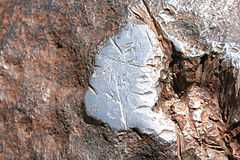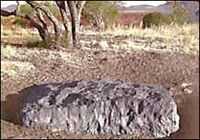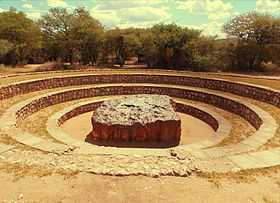Hoba meteorite
| Hoba | |
|---|---|
|
The meteorite in 2013. | |
| Type | Iron |
| Structural classification | Ataxite |
| Group | IVB |
| Composition | 84% Fe, 16% Ni |
| Country | Namibia |
| Region | Grootfontein, Otjozondjupa Region |
| Coordinates | 19°35′32.9″S 17°56′1.2″E / 19.592472°S 17.933667°ECoordinates: 19°35′32.9″S 17°56′1.2″E / 19.592472°S 17.933667°E[1] |
| Observed fall | No |
| Fall date | < 80,000 years ago |
| Found date | 1920 |
| TKW | ~60 tonnes |
 Damage caused by sampling or vandalism | |
Hoba[1] (also known as Hoba West) (pron. "HOE-bah") is a meteorite that lies on the farm "Hoba West", not far from Grootfontein, in the Otjozondjupa Region of Namibia. It has been uncovered but, because of its large mass, has never been moved from where it fell. The main mass is estimated at more than 60 tonnes,[1] making it the largest known meteorite (as a single piece) and the most massive naturally occurring piece of iron known at the Earth's surface.
The fall
The Hoba meteorite is thought to have fallen more recently than 80,000 years ago. It is inferred that the Earth's atmosphere slowed the object to the point that it fell to the surface at terminal velocity, thereby remaining intact and causing little excavation. Assuming a drag coefficient of about 1.3, the meteor would have been slowed to a mere 716 miles per hour (320 metres per second (1,000 ft/s); contrast this with typical orbital speeds of several km/s). The meteorite is unusual in that it is flat on both major surfaces, possibly causing it to have skipped across the top of the atmosphere in the way a flat stone skips on water.
Discovery

The Hoba meteorite left no preserved crater and its discovery was a chance event. The owner of the land, Jacobus Hermanus Brits, encountered the object while ploughing one of his fields with an ox. During this task, he heard a loud metallic scratching sound and the plough came to an abrupt halt. The obstruction was excavated, identified as a meteorite and described by Mr. Brits, whose report was published in 1920 and can be viewed at the Grootfontein Museum in Namibia.
Friedrich Wilhelm Kegel took the first published photograph of the Hoba meteorite.[2]
Description and composition
Hoba is a tabloid body of metal, measuring 2.7×2.7×0.9 metres (8.9×8.9×3.0 ft). In 1920 its mass was estimated at 66 tons. Erosion, scientific sampling and vandalism have reduced its bulk over the years. The remaining mass is currently estimated at just over 60 tons. The meteorite is composed of about 84% iron and 16% nickel, with traces of cobalt. It is classified as an ataxite iron meteorite belonging to the nickel-rich chemical class IVB. A crust of iron hydroxides is locally present on the surface, owing to weathering.
Modern history
In an attempt to control vandalism and with permission from Mrs. O. Scheel, owner of the farm at the time, the government of Namibia (then South West Africa) on March 15, 1955, declared the Hoba meteorite to be a national monument.[3] In 1985 Rössing Uranium Ltd. made resources and funds available to the Namibian government to provide additional protection against vandalism. In 1987 Mr. J. Engelbrecht, the owner of Hoba West farm, donated the meteorite and the site where it lies to the state for educational purposes. Later that year the government opened a tourist centre at the site. As a result of these developments, vandalism of the Hoba meteorite has ceased and it is now visited by thousands of tourists every year.
See also
Notes and references
- ↑ 1.0 1.1 1.2 Meteoritical Bulletin Database: Hoba
- ↑ Spencer, L. J.; Hey, M. H. (March 1932). "Hoba (South-West Africa), the largest known meteorite". The Mineralogical Magazine and Journal of the Mineralogic Society. XXIII (136): 4.
- ↑ Geochimica et Cosmochimica Acta (Geochemical Society. Pergamon Press) 31: 1470. 1967. doi:10.1016/0016-7037(67)90021-X. ISSN 0016-7037. Missing or empty
|title=(help)
Further reading
- Universe: The Definitive Visual Dictionary, Robert Dinwiddie, DK Adult Publishing, (2005), pg. 223.
- P. E. Spargo, "The History of the Hoba Meteorite Part I: Nature and Discovery," Monthly Notes of the Astronomical Society of Southern Africa 67, nos. 5/6 (2008), pp. 85–94.
- P. E. Spargo, "The History of the Hoba Meteorite Part II: The News Spreads," Monthly Notes of the Astronomical Society of Southern Africa 67, nos. 9/10 (2008), pp. 166–77.
- P. E. Spargo, "The History of the Hoba Meteorite Part III: Known and Loved by All," Monthly Notes of the Astronomical Society of Southern Africa 67, no. 12 (2008). Full text at The Free Library
External links
| Wikimedia Commons has media related to Hoba meteorite. |
| ||||||||||||||||||||||||||||||||||||||||||||||||||||||||||||
| ||||||||||||||||||||||||||||||||||||||||||||||||||||||||||
